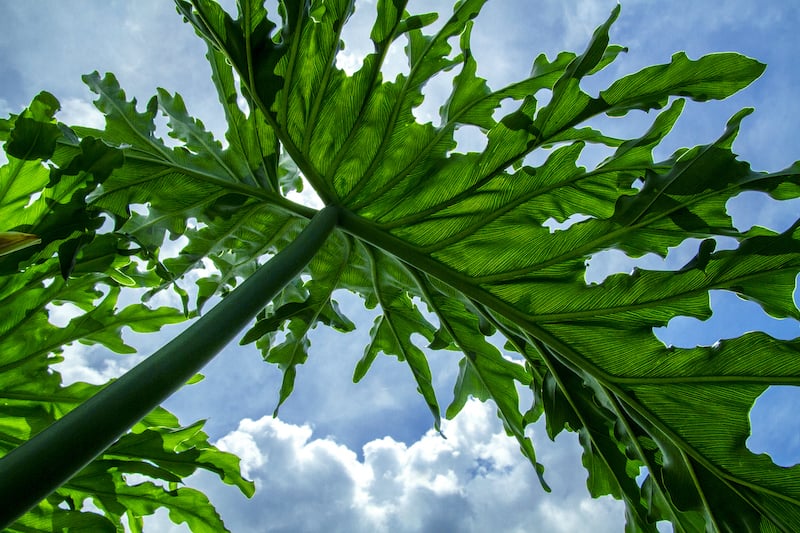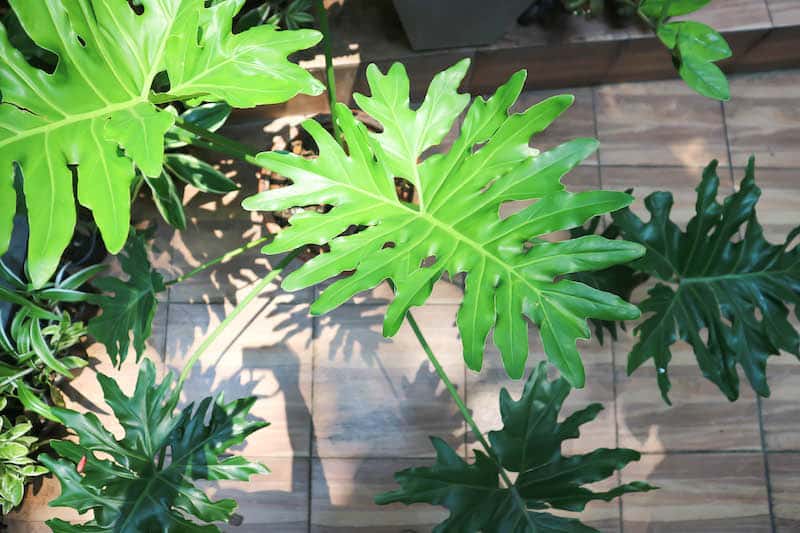The Philodendron Selloum is a popular houseplant for its large leaves with a wide spread. These are easy plants to grow and will bring a tropical feel to your home or office.
Learn how to care for the Philodendron Selloum in this guide.
Philodendron Selloum Overview
Big broad tropical leaves are what best characterize the Philodendron Selloum, also referred to as the Tree Philodendron or Philodendron bipinnatifidum. Other names it goes by include the Horsehead Philodendron, the Lacy Tree Philodendron” and the Split Leaf Philodendron”
Native to South America, and in particular Argentina, Bolivia, Brazil, and Paraguay, it can also be found on both coasts of the United States. If you want a tropical atmosphere in your home or office, this is a philodendron worth considering.
A member of the philodendron genus, which has hundreds of varieties, this particular philodendron variety is easily recognized by its gigantic lobed leaves.
The foliage is green and shiny, featuring unique cutouts for a pattern, and its fruit can be cooked and eaten. You’ll need a large space, however, as a location.

Philodendron Selloum Care Guide
When cultivating a Philodendron Selloum, choose a location with ample space, such as a large room, a balcony, a terrace, or similar. Follow the care tips below to keep your Selloum plant healthy.
Soil for the Philodendron Selloum
Soil for this philodendron should be enriched and well-draining soil.
Equal parts of orchid bark, compost, coco coir, and perlite are ideal, and the pH level should preferably be slightly alkaline. The Selloum likes a dark, fertile and alkaline soil.
This plant likes moist soil, but be sure to avoid soggy soil. Be sure to over overwatering its aerial roots.
Light for the Philodendron Selloum
This philodendron cultivar thrives in bright indirect light. In their natural habitat of a rainforest, these plants grow underneath a densely textured canopy of trees and tall plants, so light exposure is not direct, but rather dappled and filtered.
With direct sunlight or too much exposure, the foliage will turn yellow and wilt.
If your plant doesn’t get sufficient light, the leaves will turn a darker green and your plant may grow to be either stunted or leggy in search of more bright light.
This plant will grow in the direction that the light comes from, so rotating your philodendron will help with more even growth.
Water and Humidity for the Philodendron Selloum
The Philodendron Selloum is not a drought-tolerant houseplant as it comes from the rainforests, where with lots of rain and humidity. If it dries out, it will wilt and drop leaves, potentially dying.
Plan on soaking your plant and then allowing the excess water to drain through the pot’s drainage holes. The entire soil bed should be evenly moist, including the root system. The sould should be moist, but not waterlogged or soggy.
Try soaking it once weekly. Avoid overwatering or allowing roots to sit in water as this will lead to root rot and possibly the death of your plant. In winter, reduce watering as it’s the dormancy period.
Considering the chemicals found in most municipal water systems, it’s best to avoid using tap water. Distilled water or collected rainwater is better for your plant.
Like all native tropical plants, the Philodendron Selloum grows in a warm, humid environment. Average home humidity is sufficient, but ideally, a humidity level of 60% or higher is better. Humidity aids in keeping your plant well-hydrated.
Humidity is fundamental for tropical plants. Dry air can be improved by increasing the humidity around your plant. Use any one of these methods to boost humidity levels:
- Pebble tray
- Humidifier for the plants
- Misting your plant regularly during the week
- Group a number of plants together.
Temperature for the Philodendron Selloum
A tropical plant, the Philodendron Selloum needs a warm environment with good humidity. Environmental temperatures should measure between 70° and 80° Fahrenheit.
If you are growing your philodendron indoors, your plant should do fine. They do need to be protected from drafts from windows, doors, hallways, and heating or air conditioning units and vents.
It can be placed outside in the summer with adequate shade, especially in humid climates.
Fertilizer for the Philodendron Selloum
If your plant is well-nourished, your plant will resist diseases better. Fertilize monthly with a quality houseplant fertilizer diluted to half strength.
Pruning the Philodendron Selloum
Pruning is necessary for this houseplant to contrast exaggerated growth and to help your plant maintain the shape it prefers.
Use sterilized sharp garden shears to trim leaves at their base or stems. Remove all damaged, dead, or infected foliage. This will allow the plant to direct nutrients to healthier parts of the plant
Repotting the Philodendron Selloum
Repot your Philodendron Selloum every couple of years in a container that’s one or two sizes larger.
Signs it’s time to repot is when roots start to emerge fromthe drainage holes or soil surface, the plant’s growth ceases, or the plant is apparently suffering.
Propagating the Philodendron Selloum
A convenient way to propagate this houseplant is with stem cuttings. When you prune your plant, use the stem cuttings for propagation.
How to Propagate With a Stem Cutting
- With sterilized scissors, cut off a stem that has a leaf node intact.
- Stem cuttings can be cultivated in water or potting soil mix, and spring is the ideal time to begin propagation.
- For water propagation, place the stem cutting in a jar of water and place it in a warm place. Change the water every several days.
- After several weeks, root growth will be apparent. When roots reach at least an inch long, they can be transferred to moist potting mix.
- When using potting soil, treat the cut end of the stem cutting with root hormone. Poke a hole in moist potting soil with your finger and place your cutting in the hole. Move the soil around the base of the stem cutting to fill in the hole.
- Place the cutting in a warm location with bright indirect light.
- After several weeks, the roots will form, and they can be repotted in a larger pot if necessary.
Propagate with Plant Offsets
Like several other philodendrons, the Philodendron Selloum grows offsets. These plant babies can be separated from the mother plant.
Make sure that the babies have some roots attached before propagating. Place the offset in its own pot and care for it as you would a mature Philodendron Selloum.

Philodendron Selloum Toxicity and Pets
The Philodendron Selloum is toxic to domestic pets. The ASPCA, American Society for the Prevention of Cruelty to Animals, indicates that Philodendrons are toxic to our furry family members because they have calcium oxalate crystals.
With this in mind, philodendrons are best kept out of the reach of all small children and pets.
Calcium oxalate crystals can trigger diarrhea, respiratory problems, nausea, irritation, and swelling upon contact. Eating, chewing, or swallowing parts of the plant can provoke kidney failure in domestic pets like cats and dogs.
Symptoms of Calcium oxalate crystal ingestion to watch for include:
- Drooling
- Vomiting
- Mouth lesions
- Swelling lips, mouth, and tongue
- Diarrhea
- Problems swallowing
- Loss of appetite
- Nausea
Remove pieces of the plant that are still in a pet’s mouth and rinse it out. Skin should be rinsed if contact with the sap takes place. In the case of severe symptoms, take your pet to an animal emergency hospital for treatment as soon as possible.
Philodendron Selloum Pests, Diseases, and Problems
Yellow Leaves
Yellow leaves develop due to overwatering, although too little light can also be responsible. Check your watering schedule and the location of your plant.
Brown Leaves
A Selloum with brown leaves generally indicates underwatering, and that there is inadequate moisture and humidity.
It might be dehydrated or receiving direct sunlight leading to leaf burn. Dead and damaged foliage needs to be removed.
Brown spots can also indicate bacterial or fungal diseases. It may also indicate salty soil from a buildup of fertilizer or from a water softening system. It’s a good idea to always dilute the fertilizer to half-strength to prevent buildup.
If leaf tips turn brown and begin to curl, it’s probably been overfertilized. Flush out the soil bed and feed it plant food less often.
Pale Green Leaves
If the green leaves have turned pale, your plant is underfed and needs fertilization. It may also be receiving too much light. Try changing your plant’s location.
Leaf Drop
Overwatering is usually the cause of excessive leaf drop.
Pests
Pests are a problem for most houseplants. While a healthy Philodendron Selloum is relatively resistant to pests, it will not be immune.
Common pests to watch out for are:
- Spider mites
- Aphids
- Scale
- Mealybugs
- Fungus gnats
These pests can be removed, as much as possible, manually, especially scale and mealybugs. You can spray your plants with a strong water jet and then treat them with organic Neem oil or insecticidal soap.
Philodendron Selloum Diseases
The Philodendron Selloum is at risk for root rot due to overwatering or insufficient drainage from compacted soil or too few drainage holes.
To fix the root rot, your philodendron plant must be removed from soggy or wet soil, and any mushy roots removed. Healthy roots need to be rinsed and treated with a fungicide. Sterilize the pot and repot your Philodendron in fresh potting soil to eliminate any remaining traces of fungus. Wait a week before watering again.
Philodendron Selloum plants can also contract bacterial and fungal infections due to excessive watering.
To resolve the infections, remove infected stems, leaves, and roots. Rinse roots that are healthy and apply an organic fungicide like Neem oil. Repot your plant in a sterilized container with a fresh potting medium. Wait several days before watering.
Final Thoughts on the Philodendron Selloum
The beautiful Lacy Tree Philodendron, with its glossy deep dark green lobed leaves, can be an important decorating accent for numerous spaces. It is not fussy or difficult, and thrives with minimal care.
The Philodendron Selloum should be cultivated indoors in all regions that do not have a tropical climate. With the proper conditions, it can grow to be quite large, offering a striking decorative addition.
You might be interested in these other philodendron care articles:

